The Flavors of Vesuvius
The beginning of the concept of a fast-food restaurant in ancient Pompeii, by a smart entrepreneur which takes us to the reality of the time and of a start-up business that became a success!
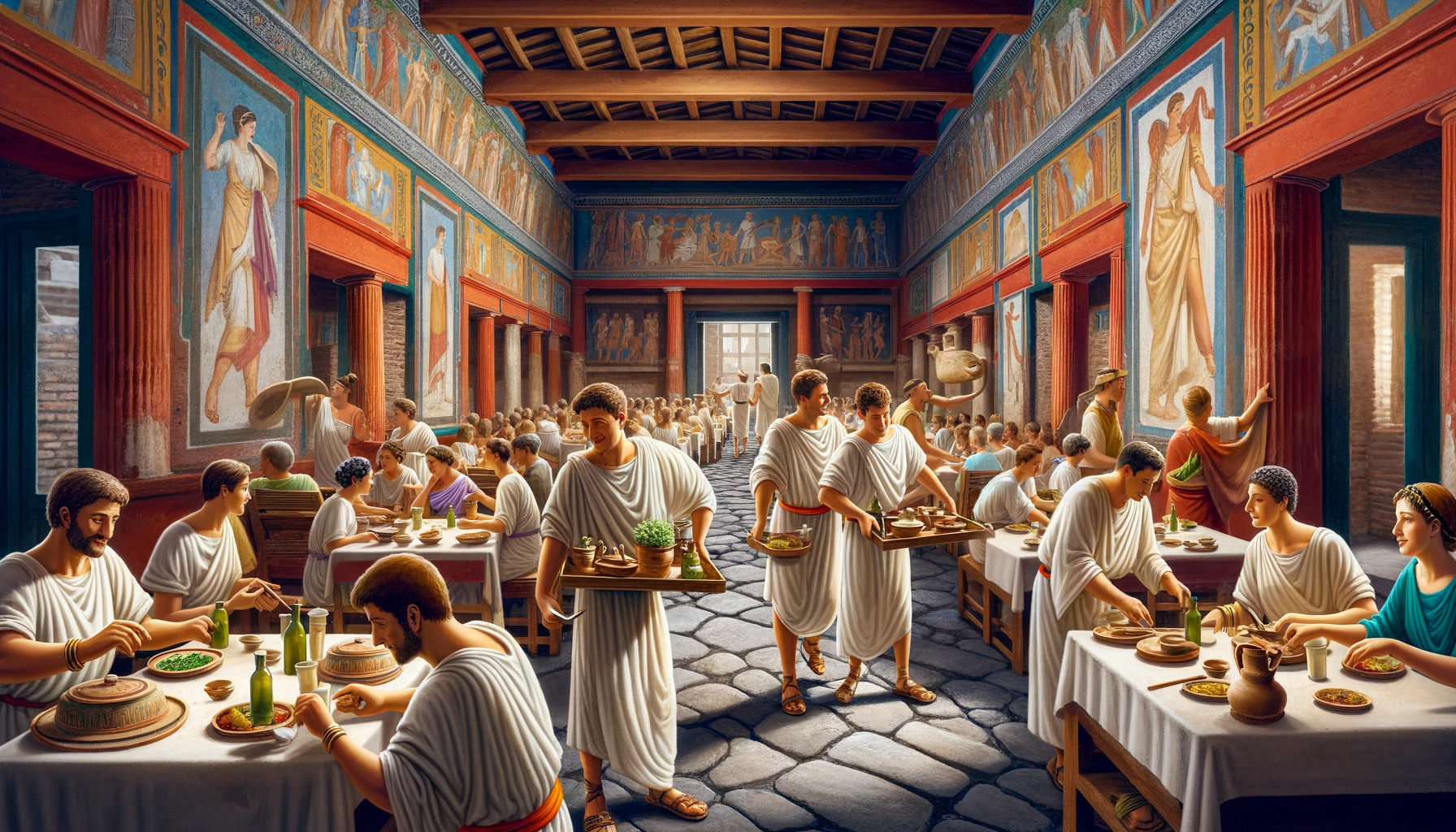
Disclaimer
This story is based on historical figures, but is ultimately a work of fiction. We're a small team of human writers, fascinated with Ancient Rome and its myriad myths and legends. Narrating fantastical stories to each other started as a hobby; and with the help of AI tools, we are able to share our passion with the rest of the world. We wholeheartedly wish you enjoy our craft – Carpe diem.
In the bustling heart of ancient Pompeii, amidst the cobblestone streets echoing with the chatter of merchants and the clatter of horse-drawn carts, there stood a small yet vibrant establishment that would, centuries later, captivate the world as one of the earliest known fast-food restaurants. It was known as the thermopolium of Lucius, a name that resonated with the warmth of its hearth and the vision of its founder, Lucius.
Lucius, a man of modest beginnings, had traversed the Roman Empire, from the hills of Rome to the sands of Egypt. His travels had imbued in him an eclectic taste and a vision to bring the convenience of varied cuisines to the common folk of Pompeii, who, unlike the elite, could not afford elaborate meals or private cooks.
Lucius: A Man of Vision and Warmth
Lucius was a man of average height, standing just a little over five feet, a stature quite common in ancient Rome. His appearance was marked by a rugged handsomeness, with deep-set hazel eyes that often sparkled with a blend of kindness and shrewd intelligence. His hair, a chestnut brown, was usually kept short, practical for a man who spent much of his time in the heat of a kitchen. His skin bore the tan of a man familiar with outdoor work, etched with fine lines that spoke of his years of travel and toil.
Dressing in the simple tunic of a Roman citizen, Lucius preferred functionality over fashion. His clothes were always clean but well-worn, a testament to his practical nature. On his feet, he wore sturdy sandals, capable of enduring long hours of standing and walking.
Lucius's education was not formal; he was no scholar or philosopher. However, his travels across the Empire had been his classroom. He learned from the people he met, the foods he tasted, and the cultures he experienced. This informal education gave him a unique perspective on life, one that was grounded in practical knowledge and worldly wisdom.
The story of Lucius's family was a humble one. His parents were not of noble birth; they were commoners, his father a craftsman and his mother a weaver. They instilled in him the values of hard work and the importance of community. Lucius's dreams were simple yet profound – to create a gathering place for all, where food was not just a necessity but a joy to be shared.
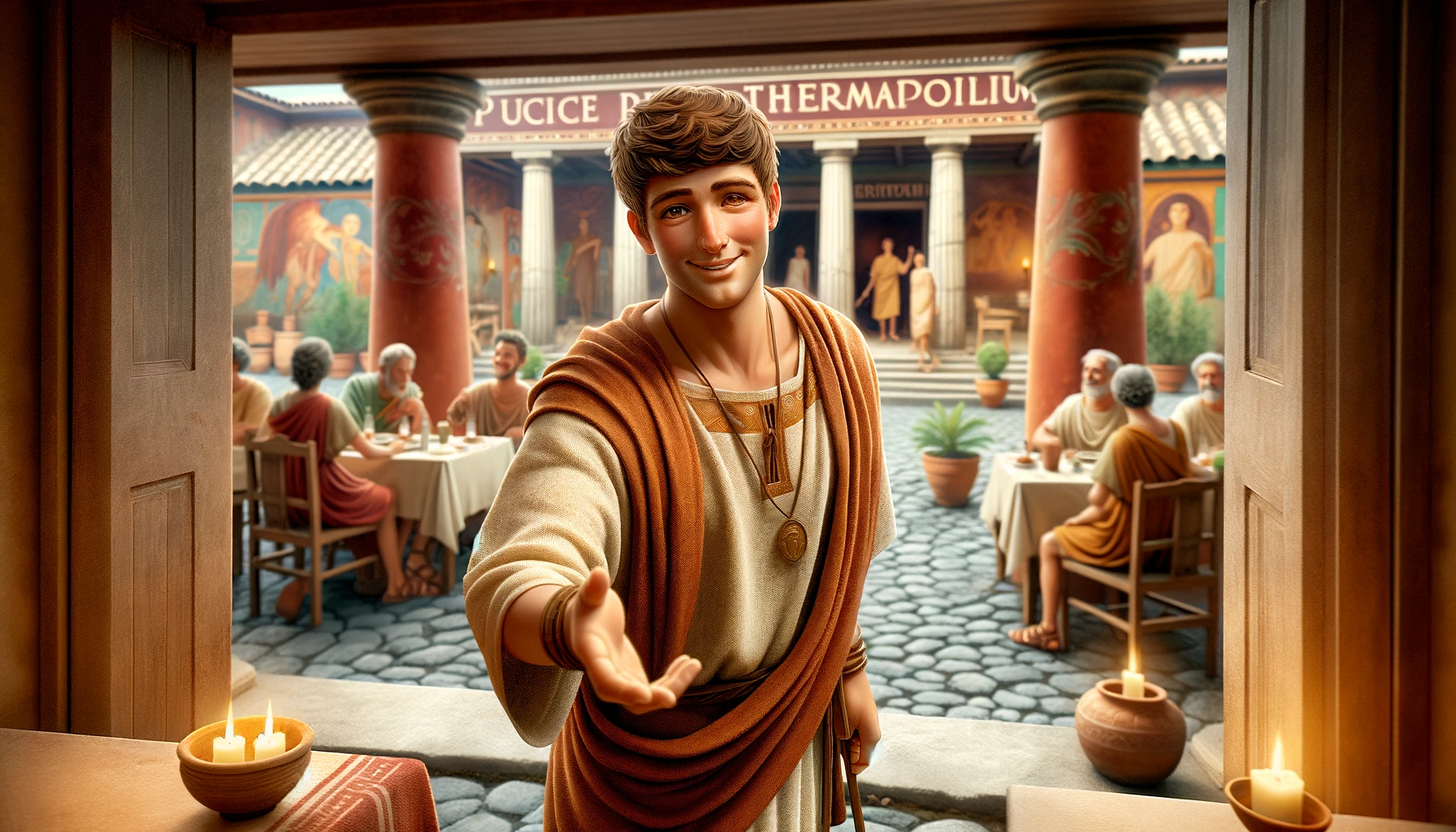
Lucius was a family man. He had married his childhood sweetheart, Julia, a woman of gentle spirit and strength. Together, they had two children, a son and a daughter, who grew up playing in the alleys of Pompeii, their laughter often echoing through the streets. Julia was a constant support to Lucius, her wisdom and insight often guiding him through the challenges of running a business.
The journey to opening his thermopolium was not an easy one for Lucius. He started with little capital, most of which he had saved from his years of working as a merchant. The rest came from modest loans from friends and family, who believed in his vision. He chose the location carefully, a busy corner of Pompeii where people from all walks of life crossed paths.
His business acumen was largely self-taught, honed by years of observing marketplaces and interacting with customers. He understood the value of location, customer service, and the quality of food. Lucius was not just selling meals; he was creating an experience, a place where people could come together, share stories, and enjoy the flavors of the Empire.
Lucius's success was not defined by wealth or prestige, but by the smiles of his satisfied customers, the bustling noise of his thermopolium, and the warmth of the community he helped foster. His legacy, unearthed centuries later, is a reminder of the timeless nature of good food and good company, and of the enduring spirit of those who dare to dream and create.
The thermopolium
The thermopolium, nestled at the corner of a lively street, was an eye-catching sight. Vivid frescoes adorned its exterior, depicting various culinary delights, hinting at the gastronomic wonders inside. These paintings were among Pompeii's first attempts at marketing, drawing patrons in with the promise of flavors yet untasted. The counter, made of coarse stone, had large dolia (terracotta jars) embedded within, brimming with ready-to-eat meals.

Lucius's menu was as diverse as his travels. He served dishes ranging from spiced wine and barley soups to more exotic offerings like baked cheese, dormice cooked with honey and poppy seeds, and even delicacies like garum, a fermented fish sauce. The food was affordable, cooked in bulk, and served quickly, catering to the bustling life of Pompeii's citizens.
The operations of the thermopolium were a marvel of efficiency and simplicity. Slaves and free workers, each with designated roles, ran the establishment under Lucius's watchful eye. Some tended to the cooking, which was done in a kitchen at the back, equipped with a large hearth and clay pots. Others managed the sales, handling the copper coins that clinked onto the counter, a simple yet effective system for profit collection.
Lucius's entrepreneurial spirit did not stop at the kitchen's edge. He understood the power of word-of-mouth in a tight-knit community like Pompeii. He often engaged with his customers, asking about their families and sharing stories of his travels, turning each visit into a personal experience. This rapport with his patrons was an early form of customer relationship management, ensuring that they returned, often bringing new customers with them.
The Vibrant Heart of Pompeii: The Thermopolium of Lucius
The interior of Lucius's thermopolium was a visual delight, reflecting the vibrancy of Pompeii's street life. The walls, bathed in warm shades of ochre and terracotta, were adorned with frescoes that were both artistic and functional. These paintings depicted scenes of food, daily life, and even whimsical representations of the gods, acting as a visual menu for the literate and illiterate alike.
The arrangement of the space was practical yet inviting. Wooden tables and stools were scattered around, not too densely packed, allowing for easy movement and conversation among patrons. The furniture was simple, made of local wood, sturdy and functional. There were no reservations; the thermopolium was a place of spontaneous visitation, catering to the bustling rhythm of Pompeian life.
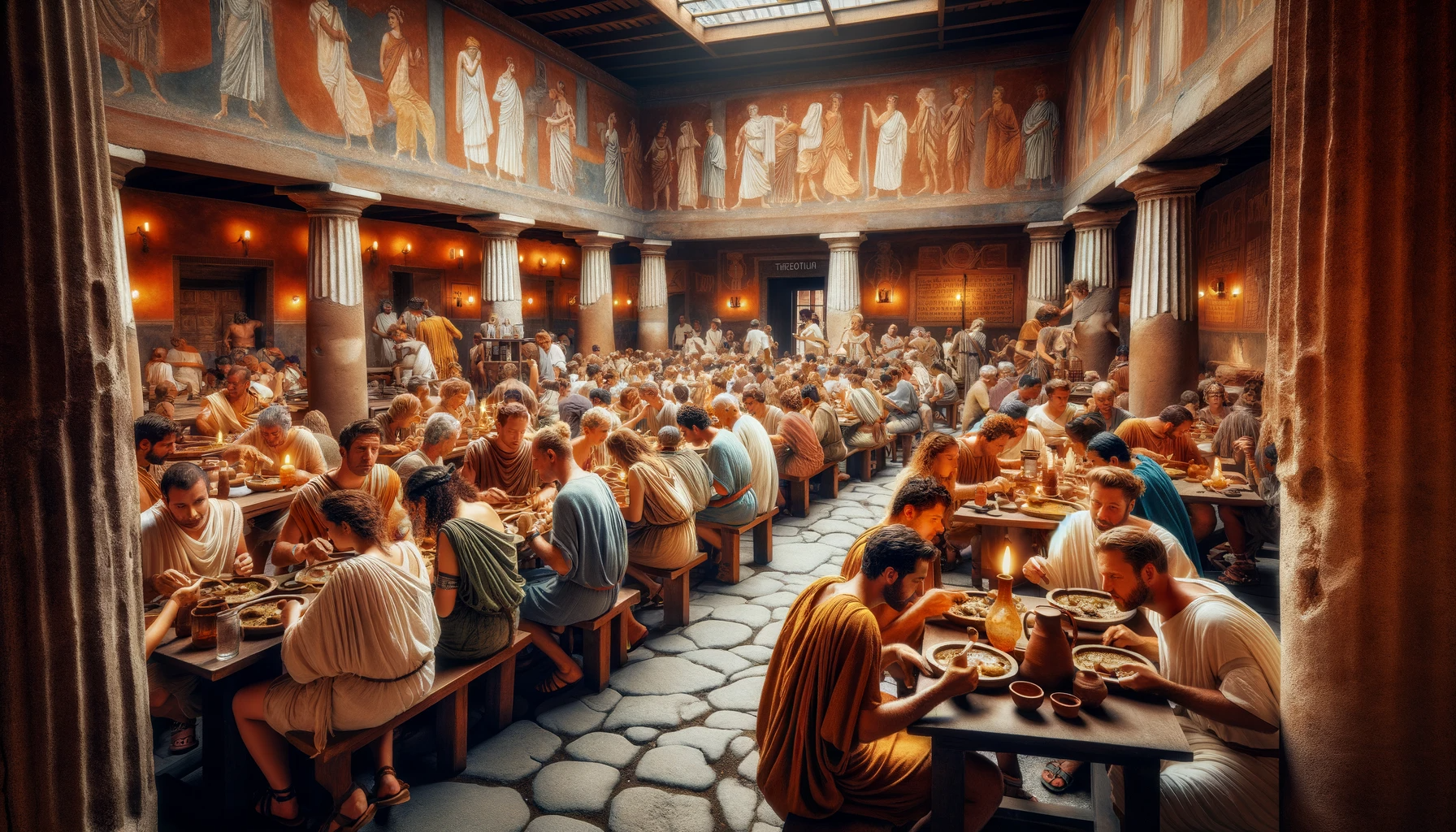
As the sun dipped below the horizon, the thermopolium transformed under the soft glow of oil lamps. These lamps, placed strategically around the room and on tables, cast a warm, inviting light, creating an ambiance that was both cozy and lively.
Music was not a daily feature but was present during festivals and special occasions. Local musicians would be invited to play the lyre or flute, adding to the festive atmosphere. These nights were looked forward to by the regulars, a chance to enjoy good food, music, and the company of friends and family.
Lucius prided himself on his selection of wines, sourced from across the Roman Empire. He offered a range from the common vinum to the more expensive and refined varieties, catering to the tastes and pockets of a diverse clientele. Each wine was stored in amphorae and served in modest, clay cups.
Specialties of the day were a hallmark of the thermopolium. Lucius, with his keen understanding of flavors and ingredients, would often experiment with new dishes, creating daily specials based on seasonal availability. This practice not only offered variety but also helped in managing food inventory efficiently.
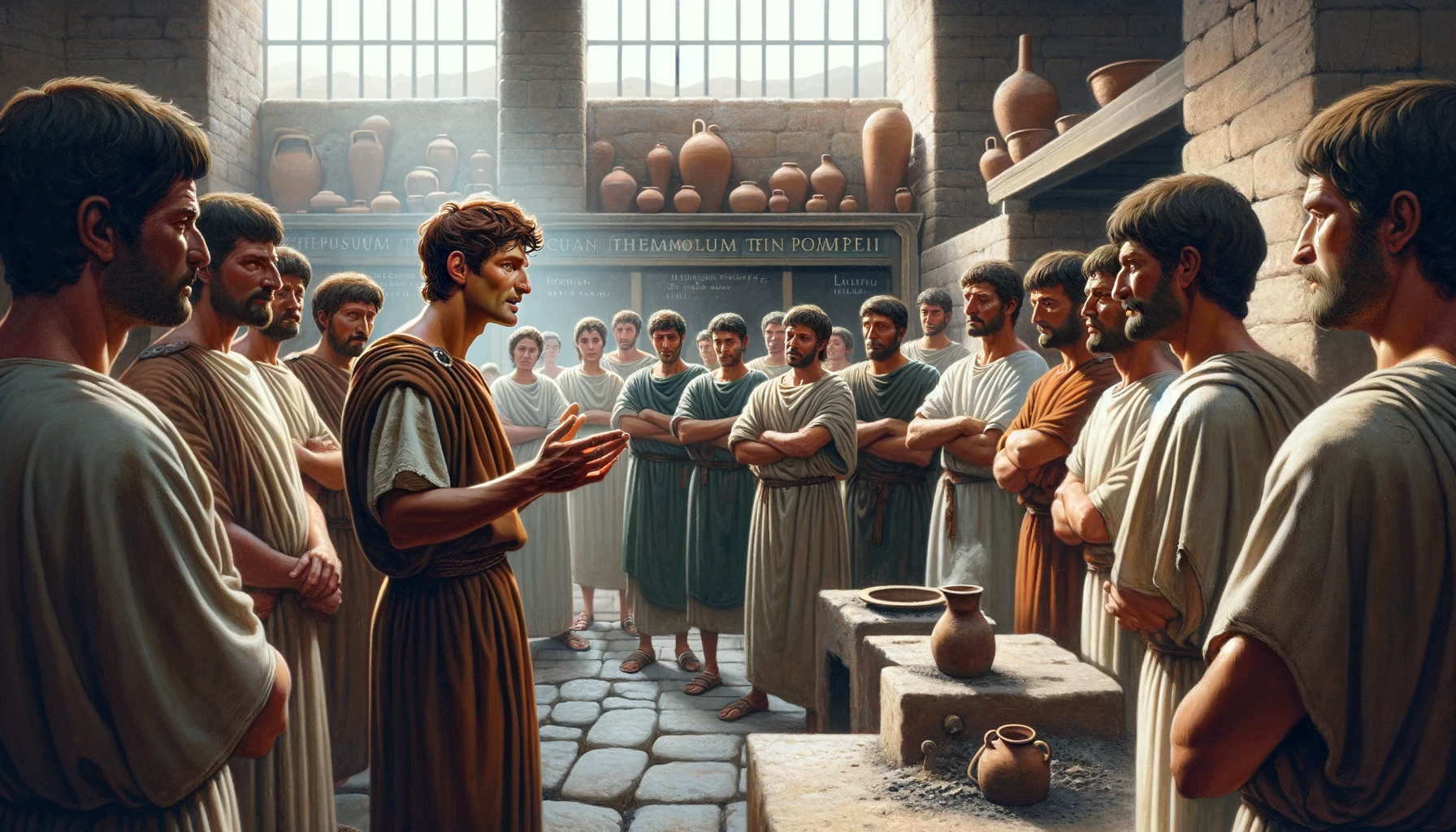
The staff at Lucius's establishment was a mix of both men and women, a reflection of the inclusive nature of his business. They were known for their friendliness and efficiency, often remembered by the regulars for their warm smiles and quick service.
Though the concept of happy hour was not known in ancient times, Lucius did have special offerings during festivals or important market days, where he would offer discounts or serve special dishes to attract more customers.
The most famous dish of the thermopolium, one that had people coming back for more, was the "Minutal Pompeianum," a Pompeian fricassee. It was a stew made of diced pork and a variety of fruits like apples and pears, cooked in a sauce of wine, garum, and spices. This dish, rich in flavor and aroma, became synonymous with Lucius's culinary artistry, a taste that defined the essence of Pompeii's street food culture.
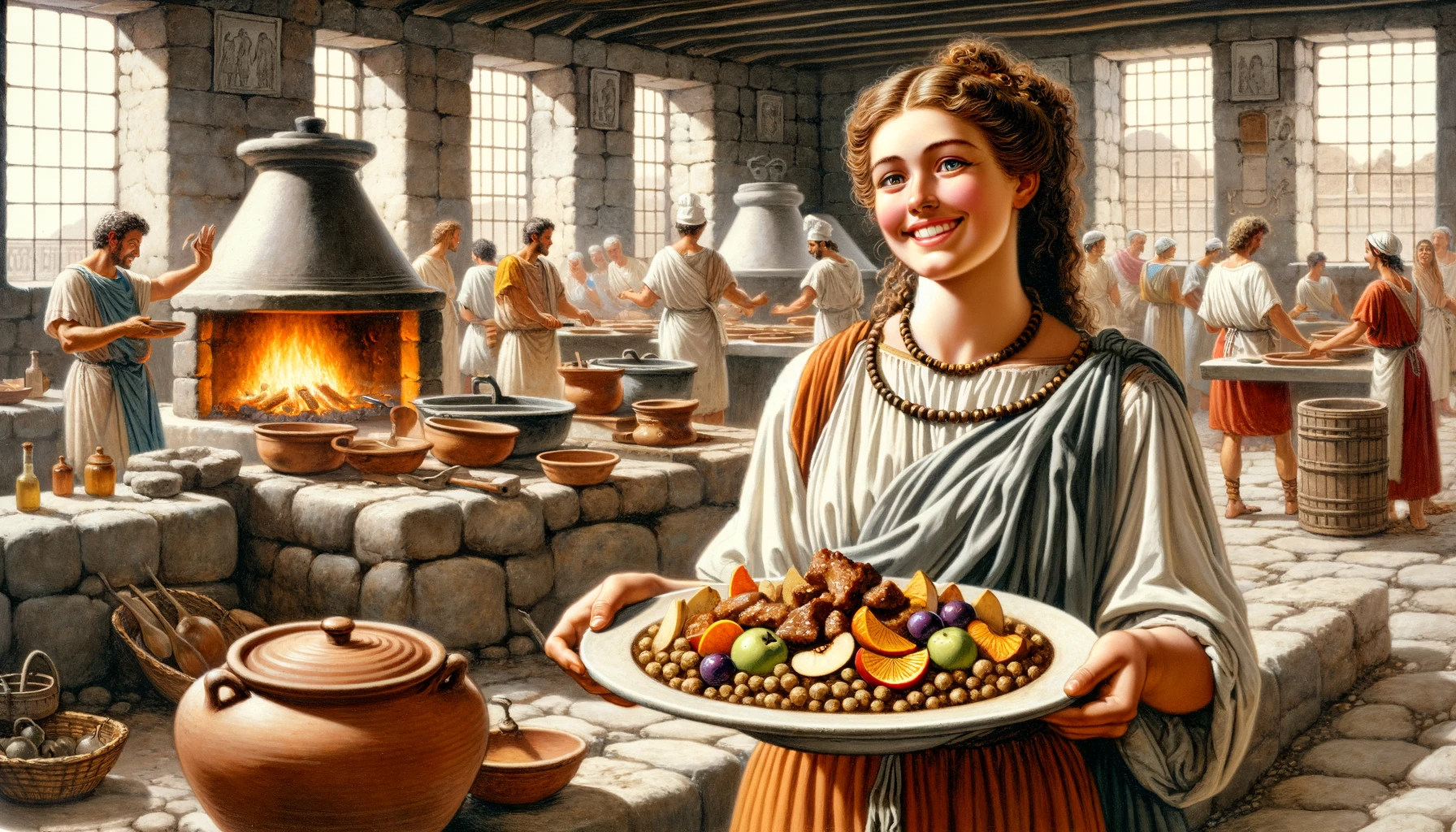
In the heart of Pompeii, the Thermopolium of Lucius stood not just as a place to eat but as a vibrant social hub, a testament to the power of food in bringing people together. Its walls, soaked in the colors of the earth and the stories of a thousand meals, echoed with the laughter and conversations of generations, preserving a slice of ancient life in the ruins of Pompeii.
Lucius's establishment became more than just a place to eat; it was a hub of social interaction, where news and gossip flowed as freely as the wine. Patrons, from laborers to traders, would gather, sharing stories over cups of warm, spiced wine, finding a moment's respite from their daily toils.
As the sun set on Pompeii each day, the thermopolium's lanterns would light up, casting a warm glow on the faces of the diners. In these moments, Lucius often reflected on his journey, from a wandering merchant to a beloved figure in Pompeii's culinary scene.
But this prosperity was not to last. In 79 AD, Mount Vesuvius erupted, covering Pompeii in a thick layer of ash and pumice. The thermopolium, along with the rest of the city, was buried, its flavors and stories preserved under the volcanic debris…

Centuries later, archaeologists uncovered the thermopolium, and with it, the story of Lucius and his pioneering fast-food restaurant. The frescoes, once vibrant, were faded but still told a vivid tale of a bustling eatery that once fed the citizens of Pompeii.
The discovery of the thermopolium of Lucius offered a glimpse into the daily life of ancient Pompeians and the ingenuity of early entrepreneurs like Lucius. His legacy, encapsulated in the ruins, serves as a testament to the enduring nature of culinary innovation and community spirit, elements that continue to define the essence of food culture even today.
In the shadows of Vesuvius, Lucius's dream thrived, feeding the hungry and bringing people together. His story, though buried for millennia, now serves as a bridge connecting us to the distant past, reminding us of the simple yet profound joys of a meal shared in good company.
The discovery of the thermopolium





About the Roman Empire Times
See all the latest news for the Roman Empire, ancient Roman historical facts, anecdotes from Roman Times and stories from the Empire at romanempiretimes.com. Contact our newsroom to report an update or send your story, photos and videos. Follow RET on Google News, Flipboard and subscribe here to our daily email.
Follow the Roman Empire Times on social media: